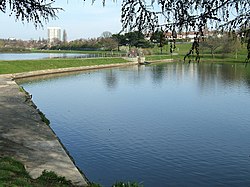Kingstanding
| Kingstanding | |
| Staffordshire | |
|---|---|
 Witton Lakes | |
| Location | |
| Grid reference: | SP085945 |
| Location: | 52°32’53"N, 1°52’23"W |
| Data | |
| Population: | 25,334 (2011[1]) |
| Post town: | Birmingham |
| Postcode: | B44 |
| Dialling code: | 0121 |
| Local Government | |
| Council: | Birmingham |
| Parliamentary constituency: |
Birmingham Erdington |
Kingstanding is an urban area in southern Staffordshire that forms a northerly suburb of Birmingham. It is bordered to the north-east by Sutton Park in Warwickshire; to the south-east by Erdington (Warks); and to the south-west by Hamstead (Staffs).
History
The name of the area is derived from the occasion when the Stuart King Charles I supposedly reviewed his troops standing on the Neolithic Bowl Barrow in the area on October 18, 1642 during the Civil War, after his stay at nearby Aston Hall. The first references to Kingstanding were as King's Standing.
The course of the Icknield Street Roman Road runs past this barrow; and when the foundations for the water pumping station were being dug in 1884, a hoard of Roman coins was discovered.[2]

The area was largely rural until the 1928, when large-scale residential development commenced in the area.[2] The first of the estates was completed in 1934.[3] It was during the 1930s and 1940s that most of the current housing was built. Most of the houses in Kingstanding were built as council houses with the majority being located in the north of the area. At the time, it was the largest council housing development in Europe, containing some 6,700 properties on its completion.[4]
In 1935, an Odeon cinema, designed by Cecil Clavering,[5] was opened on Kingstanding Circle.[6] On June 6, 1964, Kingstanding Library opened. It had an area of 1,000 sq. ft and was identified as being liable to mining subsidence.[7]
Kingstanding is featured in the novel The Last Viking by Dr Ron Dawson. The author grew up at number 79 Parkeston Crescent, and used the estate and its many characters as the backcloth to his Birmingham-based novel.[8]
Notable residents
- Lloyd Dyer, professional footballer, attended Cardinal Wiseman School between 1994-1999
- Dr Ron Dawson. Educationist, researcher and author lived in Parkeston Crescent, attended Twickenham Road School, 1945-1951.[9]
- Kingstanding is the headquarters of the 23 Special Air Service Regiment.[10]
References
- ↑ "Birmingham Ward population 2011". http://www.neighbourhood.statistics.gov.uk/dissemination/LeadKeyFigures.do?a=7&b=13689697&c=Kingstanding&d=14&e=62&g=6362122&i=1001x1003x1032x1004&m=0&r=1&s=1450095595750&enc=1. Retrieved 14 December 2015.
- ↑ 2.0 2.1 Raven, Michael (2005). A Guide to Staffordshire and the Black Country, the Potteries and the Peak. Michael Raven. pp. 151. ISBN 0-906114-33-0.
- ↑ Helen Elizabeth Meller (1997). Towns, Plans and Society in Modern Britain. Cambridge University Press. ISBN 0-521-57644-X.
- ↑ [1]
- ↑ Jane Turner (1996). The Dictionary of Art. Grove. ISBN 1-884446-00-0.
- ↑ Anne Massey (2000). Hollywood Beyond the Screen: Design and Material Culture. Berg Publishers. ISBN 1-85973-321-2.
- ↑ Library Association (1964). The Library Association Record. Library Association.
- ↑ The Last Viking
- ↑ [2]
- ↑ Hurst, Ben (26 December 2008). "SAS to march through Birmingham to receive freedom of city". Birmingham Mail. http://www.birminghammail.co.uk/news/local-news/sas-to-march-through-birmingham-to-receive-75447. Retrieved 5 May 2015.